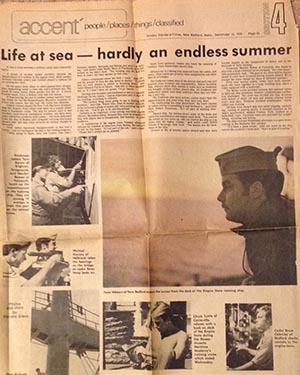My 1979 story on the Massachusetts Maritime Academy summer training cruise. Pamela Glass photo.I was cleaning out some old files the other day and came across a real gem: One of the first stories I ever wrote as a young reporter for the daily newspaper in New Bedford, Mass. The date: Sept. 16, 1979. The topic: The annual summer training cruise for cadets at the Massachusetts Maritime Academy.
Not much older than many of those cadets, I spent several days onboard the vessel, observing the training and the cadets’ adaptation to sea life.
Thirty-six years later, it appears that not much has changed. Cadets complained about the food (“yuck,” said one), the boredom, the loneliness, and a few got thrown off for discipline problems. (Back then, it was for smoking marijuana onboard, not to mention the nine cadets arrested in Bermuda on various charges.)
But what struck me most was to read that the problems they experienced with the training ship closely channeled the current-day challenges facing maritime academies as they struggle to offer at-sea training under tight budgets on antiquated ships.
On this particular cruise, Mass Maritime cadets did not sail on their school’s vessel. They were borrowing the Empire State from the State University of New York Maritime College. I did a little online sleuthing and was able to determine that this would have been the Empire State V, a former troop transport vessel built in 1950 and in service at SUNY Maritime from 1973-1990. It would have been 29 years old at the time of the Mass Maritime cruise, and my article noted that the ship was experiencing mechanical problems that delayed the departure from Boston.
“It seems that we were always at anchor or breaking down,” one cadet told me then.
Cadets in 2016 would be envious of their brethren in 1979, as they were lucky to be sailing on a ship that was only 29 years old. The average age of a training vessel today is 37. Ironically, SUNY Maritime has the oldest ship in the training fleet. The Empire State VI, a former breakbulk cargo freighter, is a relic at 53 years old.
Academy cadets gain valuable sea time and the training necessary to earn their Merchant Mariner licenses during the training cruises. But academy officials have complained to the Maritime Administration and Congress that the old ships compromise this training. Many vessels are powered by steam-driven propulsion systems, while the modern vessels use diesel engines. Many vessels also have habitability issues and don’t meet current-day environmental standards for emissions.
Why are the ships so old? Vessels that today are called the Empire State, the State of Michigan or the Kennedy, are converted tankers or bulk carriers, drawn from the inventory of U.S. ships in reserve. These often involve costly conversions.
Marad has launched a new plan to replace the aging ships and give cadets a more modern experience. The agency wants to build five new “national security multimission vessels,” which would be outfitted for cadet training but also be available during national disasters, emergencies and humanitarian missions.
Last year, $5 million was appropriated to begin design work for the new vessel concept, and Marad will soon solicit shipyard interest and qualifications, according to Kim Strong, Marad spokeswoman.
President Obama has asked Congress to approve another $6 million to fund an “independent requirements and alternatives analysis” of cadet training needs that will help inform the acquisition strategy, she said.
SUNY Maritime, with its half-century old Empire State VI, is in line to receive the first vessel.




